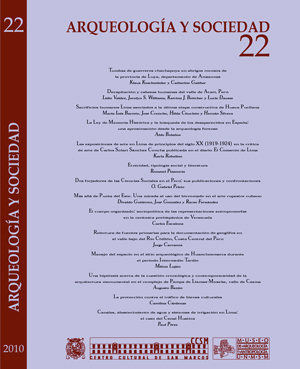A HYPOTHESIS ABOUT CHRONOLOGY AND CONTEMPORARY OF MONUMENTAL ARCHITECTURE IN THE PAMPA DE LLAMAS-MOXEKE COMPLEX, CASMA VALLEY
DOI:
https://doi.org/10.15381/arqueolsoc.2010n22.e12300Keywords:
Pampa de Llamas Moxeke, Early Formative period, chronological improvement, Chavín phenomenon, art styles, early monumental architecture.Abstract
The present study raises a hypothesis based on the architectural evidence and figurative art reviewed by the author. We argue a chronological distinction between the two platforms mounds embedded in the archaeological site of Pampa de Llamas-Moxeke in the Casma Valley. Stylistic differentiation in both lines of evidence, plus some radiocarbon dates issues, suggest that the Huaca Moxeke, postulated as a center of religious function, is the main mound in the original design planned for this complex, representative of the defined Casma Pattern proposed by Carlos Williams (1980). While Huaca A, with associated sunken plazas (square and circular) intended as a repository of elite goods (Pozorski and Pozorski 1986), is possibly a late introduction into the Early Formative Period (1800-1000 B.C.). This building is intrusive to the original design of the site but based harmonically on it. The latter doesn´t imply a strong change on the orientation of the architectural components and may represent an innovation due to new social orders perhaps related to the further deployment of the Chavin phenomenon.Downloads
Published
Issue
Section
License
Copyright (c) 2010 Augusto Bazán Pérez

This work is licensed under a Creative Commons Attribution-NonCommercial-ShareAlike 4.0 International License.
THE AUTHORS RETAIN THEIR RIGHTS:
a. The authors retain their trademark and patent rights, and also on any process or procedure described in the article.
b. The authors retain the right to share, copy, distribute, perform and publicly communicate the article published in the Arqueología y Sociedad (for example, place it in an institutional repository or publish it in a book), with an acknowledgment of its initial publication in the Arqueología y Sociedad.
c. The authors retain the right to make a subsequent publication of their work, to use the article or any part of it (for example: a compilation of their works, notes for conferences, thesis, or for a book), provided that they indicate the source. of publication (authors of the work, journal, volume, number and date).






